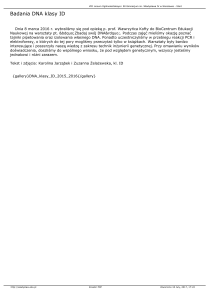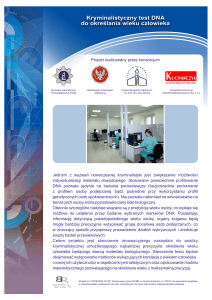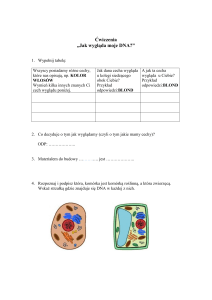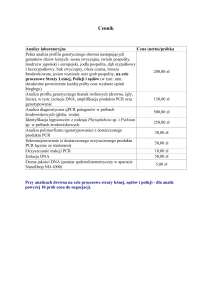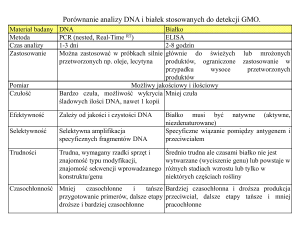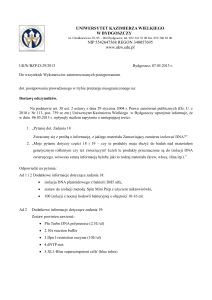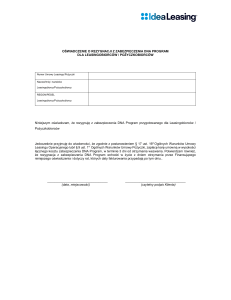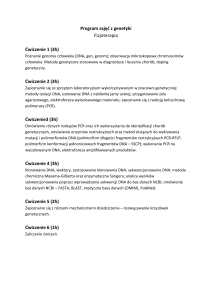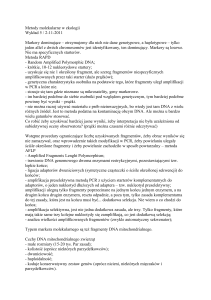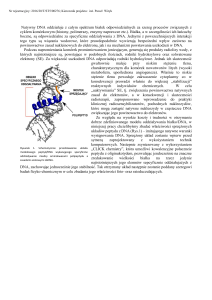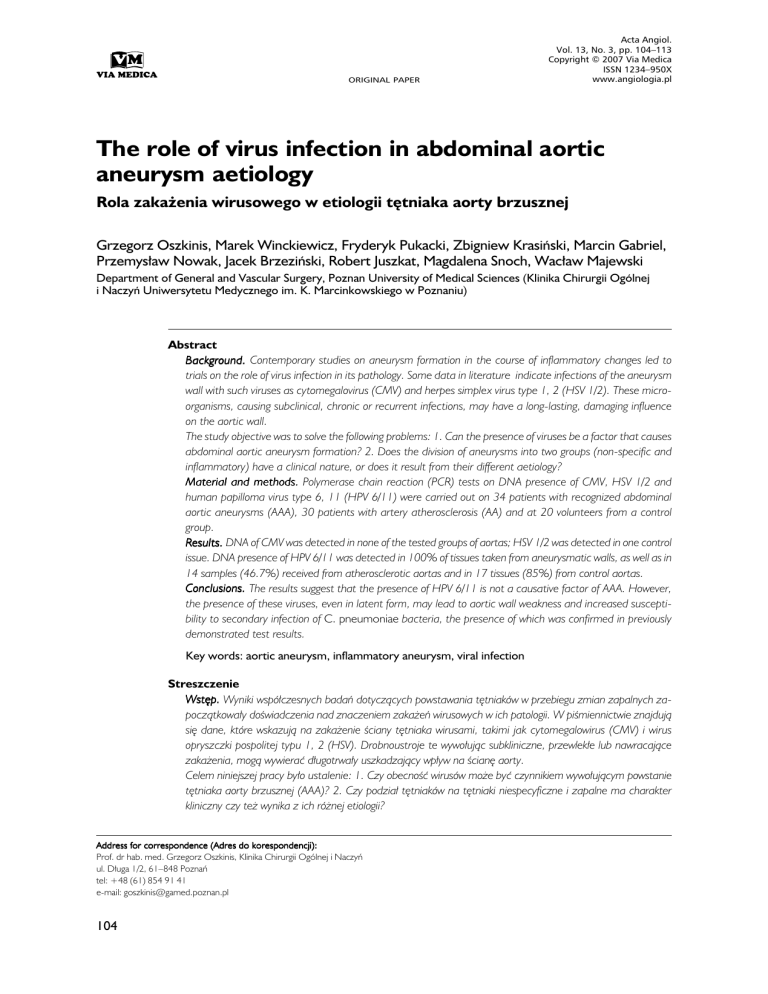
ORIGINAL PAPER
Acta Angiol.
Vol. 13, No. 3, pp. 104–113
Copyright © 2007 Via Medica
ISSN 1234–950X
www.angiologia.pl
The role of virus infection in abdominal aortic
aneurysm aetiology
Rola zakażenia wirusowego w etiologii tętniaka aorty brzusznej
Grzegorz Oszkinis, Marek Winckiewicz, Fryderyk Pukacki, Zbigniew Krasiński, Marcin Gabriel,
Przemysław Nowak, Jacek Brzeziński, Robert Juszkat, Magdalena Snoch, Wacław Majewski
Department of General and Vascular Surgery, Poznan University of Medical Sciences (Klinika Chirurgii Ogólnej
i Naczyń Uniwersytetu Medycznego im. K. Marcinkowskiego w Poznaniu)
Abstract
Background. Contemporary studies on aneurysm formation in the course of inflammatory changes led to
trials on the role of virus infection in its pathology. Some data in literature indicate infections of the aneurysm
wall with such viruses as cytomegalovirus (CMV) and herpes simplex virus type 1, 2 (HSV 1/2). These microorganisms, causing subclinical, chronic or recurrent infections, may have a long-lasting, damaging influence
on the aortic wall.
The study objective was to solve the following problems: 1. Can the presence of viruses be a factor that causes
abdominal aortic aneurysm formation? 2. Does the division of aneurysms into two groups (non-specific and
inflammatory) have a clinical nature, or does it result from their different aetiology?
Material and methods. Polymerase chain reaction (PCR) tests on DNA presence of CMV, HSV 1/2 and
human papilloma virus type 6, 11 (HPV 6/11) were carried out on 34 patients with recognized abdominal
aortic aneurysms (AAA), 30 patients with artery atherosclerosis (AA) and at 20 volunteers from a control
group.
Results. DNA of CMV was detected in none of the tested groups of aortas; HSV 1/2 was detected in one control
issue. DNA presence of HPV 6/11 was detected in 100% of tissues taken from aneurysmatic walls, as well as in
14 samples (46.7%) received from atherosclerotic aortas and in 17 tissues (85%) from control aortas.
Conclusions. The results suggest that the presence of HPV 6/11 is not a causative factor of AAA. However,
the presence of these viruses, even in latent form, may lead to aortic wall weakness and increased susceptibility to secondary infection of C. pneumoniae bacteria, the presence of which was confirmed in previously
demonstrated test results.
Key words: aortic aneurysm, inflammatory aneurysm, viral infection
Streszczenie
Wstęp. Wyniki współczesnych badań dotyczących powstawania tętniaków w przebiegu zmian zapalnych zapoczątkowały doświadczenia nad znaczeniem zakażeń wirusowych w ich patologii. W piśmiennictwie znajdują
się dane, które wskazują na zakażenie ściany tętniaka wirusami, takimi jak cytomegalowirus (CMV) i wirus
opryszczki pospolitej typu 1, 2 (HSV). Drobnoustroje te wywołując subkliniczne, przewlekłe lub nawracające
zakażenia, mogą wywierać długotrwały uszkadzający wpływ na ścianę aorty.
Celem niniejszej pracy było ustalenie: 1. Czy obecność wirusów może być czynnikiem wywołującym powstanie
tętniaka aorty brzusznej (AAA)? 2. Czy podział tętniaków na tętniaki niespecyficzne i zapalne ma charakter
kliniczny czy też wynika z ich różnej etiologii?
Address for correspondence (Adres do korespondencji):
Prof. dr hab. med. Grzegorz Oszkinis, Klinika Chirurgii Ogólnej i Naczyń
ul. Długa 1/2, 61–848 Poznań
tel: +48 (61) 854 91 41
e-mail: [email protected]
104
The role of virus infection in AAA aetiology, Oszkinis et al.
Materiał i metody. Badania reakcji łańcuchowej polimerazy (PCR) na obecność DNA CMV, HSV 1/2 i wirusa
brodawczaka ludzkiego typu 6, 11 (HPV 6/11) wykonano u 34 osób z rozpoznanym AAA, u 30 chorych
z miażdżycą aorty (AA) i u 20 osób z grupy kontrolnej.
Wyniki. W żadnej badanej grupie aort nie wykryto występowania DNA CMV, natomiast HSV 1/2 wykryto
w jednej tkance kontrolnej. Obecność DNA HPV 6/11 stwierdzono w 100% tkanek pobranych ze ściany tętniaków, jak również w 14 próbach (46,7%) pochodzących z aort zmienionych miażdżycowo i 17 tkankach (85%)
aort kontrolnych.
Wnioski. Wynik sugeruje, że obecność wirusa HPV 6/11 nie jest czynnikiem sprawczym powstania AAA. Obecność tych wirusów, nawet w formie utajonej, może jednak spowodować osłabienie ściany aorty i zwiększoną
podatność na wtórne zakażenie — na przykład bakterią C. pneumoniae, której obecność potwierdzono we
wcześniej prezentowanych wynikach badań.
Słowa kluczowe: tętniak aorty, tętniak zapalny, zakażenie wirusowe
Introduction
Wstęp
There are still doubts regarding the pathophysiological mechanisms that lead to abdominal aortic aneurysm (AAA) formation. Therefore, it seems that further studies will provide even more convincing proof of
the existence of aortic ”aneurysmatic disease” as an independent pathomorphological unit.
It was proved that vessel wall structural changes in
AAA as well as in artery atherosclerosis (AA) may be
caused by different nociceptive factors. Ross and Glomset created a theory of so-called homogenous reaction
to trauma. According to this theory, endothelium or internal membrane damage done by mechanical, metabolic or immunological factors becomes a starting point of
the pathological reconstruction of the vessel wall [1, 2].
In recent years there have been some reports about the significance of infection as one of the factors in
compound etiopathogenesis of atherosclerosis. The
pathological role of such viruses as Coxackie C, herpes
simplex type 1, 2 (HSV 1/2) and cytomegalovirus (CMV)
have been described [3–5]. There is also a possibility of
developing experimental atherosclerosis in chicks (Marek’s disease) with a bird virus of the herpes type [1, 2,
6]. Confirmation for the coexistence of infection and
atherosclerosis in humans came in the form of data from
seroepidemiological research that indicated the increase of antibody titers (IgM and/or IgG class) with simultaneous confirmation of the presence of specific antigens and DNA of these micro-organisms in diseased
arteries [3, 7].
Contemporary studies on aneurysm formation in the
course of inflammatory changes have not shown such
unequivocal results as in the case of atherosclerosis and
have resulted in further research on the role of viral infections in its pathology. Some data in the literature indicate infections on the aneurysmatic wall with such viruses as CMV and HSV 1/2 [1, 4, 8]. These micro-organi-
Obecnie nadal istnieją wątpliwości dotyczące mechanizmów patofizjologicznych prowadzących do powstania tętniaka aorty brzusznej (AAA). Wydaje się więc,
że dalsze badania pozwolą dostarczyć jeszcze bardziej
przekonujących dowodów na istnienie „choroby tętniakowej” aorty jako samodzielnej jednostki patomorfologicznej.
Udowodniono, iż zmiany strukturalne, ściany naczyń
zarówno w AAA, jak i miażdżycy tętnic (AA) można wywołać za pomocą różnych czynników uszkadzających.
Ross i Glomset opracowali teorię tak zwanej jednolitej
reakcji na uraz, według której uszkodzenie śródbłonka
lub błony wewnętrznej przez czynnik mechaniczny, metaboliczny lub immunologiczny staje się początkiem patologicznej przebudowy ściany naczynia [1, 2].
Ostatnio pojawiły się doniesienia wskazujące na znaczenie zakażenia jako jednego z czynników w złożonej
etiopatogenezie miażdżycy. Opisano patologiczną rolę
wirusów, takich jak Coxackie C, wirus opryszczki ludzkiej typu 1, 2 (HSV 1/2) oraz cytomegalowirus (CMV)
[3–5]. Istnieje także możliwość wywołania doświadczalnej miażdżycy u kurcząt (choroba Mareka) wirusem należącym do ptasich wirusów z rodzaju herpes [1–2, 6].
Potwierdzeniem współistnienia zakażenia i miażdżycy
tętnic u ludzi były dane z badań seroepidemiologicznych, wykazujące na wzrost miana przeciwciał (klasy
IgM i/lub IgG) z jednoczesnym potwierdzeniem obecności swoistych antygenów i DNA tych drobnoustrojów w chorych tętnicach [3, 7].
Wyniki współczesnych badań dotyczących powstawania tętniaków w przebiegu zmian zapalnych nie były
tak jednoznaczne jak w przypadku miażdżycy i spowodowały, że podjęto dalsze doświadczenia nad znaczeniem zakażeń wirusowych w ich patologii. W piśmiennictwie znajdują się dane, które wskazują na zakażenie
ściany tętniaka wirusami CMV i HSV [1, 4, 8]. Wymie-
www.angiologia.pl
105
Acta Angiol., 2007, Vol. 13, No. 3
sms, causing subclinical, chronic or recurrent infections,
may have a long-lasting, damaging influence on the aortic
wall. [9].
However, the data regarding aortic wall infection
concerns different types of aneurysms. In Tanaka and
Yonemitsu’s studies concerning aortic wall infection with
CMV and HSV 1/2, tissues taken only from inflammatory aneurysms were used as research material [4, 8].
There is not much research on this issue, especially
in Polish literature; therefore, this topic requires further studies due to the prevalence of abdominal aortic
aneurysms in our country [10].
The leading motive of this study was to extend the
knowledge of abdominal aortic aneurysm pathogenesis
— paying particular attention to the inflammatory factor. The study was carried out to answer the following
questions:
1. Can the presence of viruses be a factor that causes
abdominal aortic aneurysm formation?
2. Does the division of aneurysms into two groups (nonspecific and inflammatory) have a clinical nature, or
does it result from their different aetiology?
In order to determine the significance of infection in
the course of aneurysm development, the coexistence
of other viruses (apart from CMV and HPV) in the AAA
wall was examined. Papilloma’s viruses — human papilloma virus type 6, 11 (HPV 6/11) were chosen for the
evaluation. They cause changes in the form of larynx
papillomatosis in the respiratory system and may have
some connection with vascular diseases [11–13].
Material and methods
The material used in the study on the presence of DNA
sequence of HPV 6/11, HSV 1/2 and CMV were specimens of abdominal aortic wall, taken from below the renal
arteries, which were aneurysmatically changed or which
had extensive atherosclerotic changes, that caused closure of the aortic lumen or its haemodynamically significant
stenosis. The specimens were taken from 34 patients operated on at the PUMS Department of General and Vascular Surgery in Poznań due to abdominal aortic aneurysm
(AAA) and from 30 patients who were given a bifurcated
aortic-double-thigh prosthesis due to extensive atherosclerosis of the final aortic section and iliac arteries. The control material consisted of the abdominal aortas taken from
20 transplant organ donors.
The group of 34 people with AAA consisted of 23
men and 11 women. The age of the patients was between 54 and 83, with an average of 65.0 ± 7.9 years. In this
group, 28 patients (82.4%) were diagnosed with nonspecific aneurysms, and 6 patients (17.6%) were diagnosed with inflammatory aneurysms (confirmed by routine
106
nione drobnoustroje, wywołując subkliniczne, przewlekłe lub nawracające zakażenia, mogą wywierać długotrwały uszkadzający wpływ na ścianę aorty [9].
Dane o istnieniu zakażenia ściany aorty obejmowały
jednak różne rodzaje tętniaków. W pracach Tanaki
i Yonemitsu dotyczących zakażenia ściany aorty wirusami CMV i HSV materiałem badawczym były tkanki pobrane tylko z tętniaków zapalnych [4, 8].
Zwłaszcza w polskim piśmiennictwie istnieje niewiele
badań omawiających to zagadnienie, co przy powszechnym występowaniu AAA wymagało podjęcia tego tematu [10].
Najważniejszym celem przeprowadzenia badań było
pogłębienie wiedzy o patogenezie AAA ze szczególnym
uwzględnieniem czynnika zapalnego. Celem przeprowadzonych badań było ustalenie:
1. Czy obecność wirusów może być czynnikiem
wywołującym powstanie AAA?
2. Czy podział tętniaków na tętniaki niespecyficzne
i zapalne ma charakter kliniczny czy też wynika z ich
różnej etiologii?
Aby określić znaczenie zakażenia w rozwoju tętniaków, badano współistnienie w ścianie AAA jeszcze innych, oprócz CMV i HSV, rodzajów wirusów. Do oceny wybrano wirusy brodawczaka ludzkiego typu 6,11
(HPV 6/11), powodującego w układzie oddechowym
zmiany w postaci brodawczakowatości krtani i być może
mającego związek z chorobami naczyń [11–13].
Materiał i metody
Materiałem do badań na obecność sekwencji DNA
HPV 6/11, HSV 1/2 i CMV były wycinki ściany aort
brzusznych, pobrane poniżej tętnic nerkowych, ze zmianami tętniakowymi lub z rozległymi zmianami miażdżycowymi, które spowodowały zamknięcie światła aorty
lub jej hemodynamicznie istotne zwężenie. Wycinki pochodziły od 34 chorych operowanych w Klinice Chirurgii Ogólnej i Naczyń Uniwersytetu Medycznego w Poznaniu z powodu AAA i od 30 chorych, którym wszyto
protezę rozwidloną aortalno-dwuudową z powodu rozległej miażdżycy końcowego odcinka aorty i tętnic biodrowych (AA). Próbę kontrolną stanowiły aorty brzuszne pobrane od 20 dawców narządów do transplantacji.
W grupie 34 osób z AAA było 23 mężczyzn i 11 kobiet. Wiek chorych wynosił 54–83 lat (śr. 65,0 ± 7,9
roku). W grupie tej u 28 chorych (82,4%) stwierdzono
tętniaki niespecyficzne i u 6 osób (17,6%) tętniaki zapalne (potwierdzone w rutynowych badaniach histopatologicznych). Wszystkich pacjentów operowano w trybie planowym i u żadnego badanego śródoperacyjnie
nie stwierdzono objawów pękania. Średnica operowanych tętniaków wynosiła 5–10 cm (śr. 6,95 ± 1,4).
www.angiologia.pl
The role of virus infection in AAA aetiology, Oszkinis et al.
histopathological examination). All patients were operated on according to schedule, and none of them was noted with burst symptoms during the operation. The diameters of the operated aneurysms were between 5 and
10 cm, with an average of 6.95 ± 1.4 cm. Among these
patients there were: 29 patients (85.3%) who smoked,
19 patients (55.9%) who were diagnosed with arterial
hypertension and 20 patients (58.8%) who had symptoms of heart muscle ischaemic disease. Five patients
(14.7%) had had an earlier operation of coronary artery
bypass grafting. Twelve patients (35.3%) were diagnosed with extensive atherosclerotic changes in bifurcations
of the iliac arteries, four of them (11.8%) were diagnosed with diabetes and seven patients (20.6%) with AAA
had cholesterol levels above 5.7 mmol/l.
In the group of 30 patients with artery atherosclerosis (AA) there were 21 men and 9 women aged from
41 to 72 with an average age of 55.2 ± 7.3 years. All
patients from this group were operated on according
to schedule, and none of them was diagnosed with aneurysmatic widening of the aorta (i.e. more than 30 mm)
during operation. In this group, 76.7% of patients were
smokers, 53.3% were diagnosed with arterial hypertension, 46.7% had symptoms of heart muscle ischaemic disease and 13.3% were earlier operated with
coronary artery bypass grafting. 26.7% of operated patients had diabetes and 30.0% of patients had increased
cholesterol levels (more than 5.7 mmol/l).
The patients with arterial hypertension were in the
course of hypotensive therapy and had normalized pressure (according to ISH/WHO, RR < 140/90 mm Hg).
The morning glycaemia level (and in some cases twenty-four-hour profile of glycaemia) of patients with diabetes indicated that diabetes was at the stage of compensation.
The age of the people in the control group ranged
from 26 to 41, with an average of 34.3 ± 5.8 years. In
this group, there were no detailed epidemiological data
apart from sex and age. The only criteria set for these
people to include them in the control studies was the
fact that they were healthy and that their organs were
qualified for transplantation. A surgeon assessed their
aortic diameter and its macroscopic image while taking
tissues. Only aortas with a diameter up to 30 mm and
without macroscopic symptoms of atherosclerosis were
qualified for the studies. The data regarding smoking
among this group of patients were not obtained.
Identification of DNA sequence of HPV 6/11,
HSV 1/2 and CMV in clinical material by PCR method
The positive controls in DNA tests done by polymerase chain relation (PCR) method were:
Wśród tych chorych 29 osób (85,3%) paliło tytoń, u 19
(55,9%) rozpoznawano nadciśnienie tętnicze i u 20
(58,8%) pacjentów stwierdzono objawy choroby niedokrwiennej serca. U 5 chorych (14,7%) wcześniej
wykonano operację pomostowania tętnic wieńcowych.
Rozległe zmiany miażdżycowe, zwłaszcza w rozwidleniach tętnic biodrowych stwierdzono u 12 chorych
(35,3%), cukrzycę u 4 (11,8%), natomiast stężenie cholesterolu powyżej 5,7 mmol/l odnotowano u 7 osób
(20,6%) z AAA.
W grupie 30 osób z AA było 21 mężczyzn i 9 kobiet,
wiek chorych wynosił 41–72 lat (śr. 55,2 ± 73 roku).
Wszystkich chorych z tej grupy operowano w trybie planowym i u żadnego badanego śródoperacyjnie nie stwierdzono tętniakowatego poszerzenia aorty (tj. > 30 mm).
Wśród tych pacjentów 76,7% osób paliło tytoń, u 53,3%
rozpoznano nadciśnienie tętnicze, u 46,7% chorych odnotowano objawy choroby niedokrwiennej serca,
a u 13,3% osób wcześniej wykonano operację pomostowania tętnic wieńcowych. Cukrzycę rozpoznano
u 26,7% operowanych, natomiast podwyższone stężenie cholesterolu (> 5,7 mmol/l) u 30,0% osób.
Chorzy z nadciśnieniem tętniczym byli w trakcie terapii hipotensyjnej i wartości ciśnienia były u nich prawidłowe (wg ISH/WHO, RR < 140/90 mm Hg). U chorych na cukrzycę poranne wartości glikemii, a w niektórych przypadkach profil dobowy glikemii wskazywały,
że cukrzyca była w stadium kompensacji.
Wiek chorych w grupie kontrolnej wynosił 26–41
lat (śr. 34,3 ± 5,8 roku). W tej grupie oprócz płci i wieku nie było szczegółowych danych epidemiologicznych.
Jedynym kryterium włączenia tych osób do badań kontrolnych było uznanie ich za zdrowe, a ich narządy za
nadające się do przeszczepów. W tej grupie podczas
pobierania tkanek chirurg oceniał średnicę aorty i jej obraz makroskopowy. Do badań kwalifikowano tylko aorty
o średnicy do 30 mm, bez makroskopowych objawów
miażdżycy. Nie udało się uzyskać informacji na temat
palenia tytoniu w tej grupie badanych.
Identyfikacja sekwencji DNA HPV 6/11, HSV 1/2
i CMV w materiale klinicznym metodą PCR
Kontrolę pozytywną w badaniach DNA za pomocą
metody reakcji łańcuchowej polimerazy (PCR) stanowiły:
— DNA izolowane z krwi osoby zdrowej, w którym
identyfikowano sekwens kodujący c-fos;
— dla CMV — DNA izolowane z tkanki pobranej od
dzieci zmarłych z powodu zakażenia CMV;
— dla HSV 1/2 — DNA izolowane z materiału klinicznego zakażonego wirusem opryszczki;
— dla HPV 6/11 — DNA izolowane z brodawczaka
krtani.
www.angiologia.pl
107
Acta Angiol., 2007, Vol. 13, No. 3
— DNA isolated from the blood of a healthy person,
which was identified with c-fos coding sequence;
— for CMV — DNA isolated from tissues taken from
children who died of CMV infection;
— for HSV 1/2 — DNA isolated from clinical material
infected with the herpes virus;
— for HPV 6/11 — DNA isolated from laryngeal papilloma.
In patients with AAA, samples for PCR tests were
taken from the frontal surface of the aneurismal sac at
the point of its greatest diameter. For people with artery atherosclerosis and people from the control group,
tissues were also taken from the frontal surface of the
aorta below the renal arteries. Originally, the material
covered the full thickness of the aorta. Then, observing
the rules of asepsis, the fragments of resected tissue
were delaminated and the muscular coat and adventitia
were left out for further tests. They were then placed
in liquid nitrogen and stored in a freezer at –80∞C until
further tests were carried out.
The operatively obtained tissues were cut into smaller fragments and were poured with 1 ml of buffer for
DNA isolation, which contained K proteinase at 50 mg/ml
concentration. After the full procedure was carried out,
the DNA was isolated defining its amount and cleanliness
through 1% agar gel electrophoresis and measuring spectrophotometrically on a BECKMANN DU 7500 spectrophotometer by Wartburg-Christian method by test
absorbance measurement at a wavelength of 260 nm.
DNA prepared in such a way was a matrix in PCR.
Electrophoretic separation of DNA isolated from
tissues was done in 1% agar gel that contained 0.5%
mg/ml ethidium bromide, in 1 ¥ TAE buffer at a voltage
of 4 V/cm for 1 hour. The products received by duplication reaction of PCR method were analyzed in 2% agar
gel that contained 0.5% mg/ml ethidium bromide, in
1 ¥ TAE buffer at a voltage of 4 V/cm for 1 hour.
In order to identify viral DNA in the DNA isolated
from aortic walls, PCR with starters specific for DNA of
the HPV 6 and HPV 11 viruses was conducted. The matrix cleanliness level of the entire human DNA isolated
from the aortic walls was checked using starters for the
c-fos genes: FOS4-1 and FOS4-2. The DNA was exposed to preliminary denaturation for 5 minutes at 94∞C,
and then 31 duplication cycles were carried out. After
duplication, the PCR products were analyzed, dividing
them in 2% agar gel with the presence of a DNA fragment size marker, which was pUC19 DNA digested with
MspI enzyme (HpaII, Fermantes, Lithuania).
In order to identify DNA of the HSV in the DNA
isolated from aortic walls, PCR with starters specific for
DNA of HSV 1 and HSV 2 was conducted. The matrix
108
Próbki do badań PCR u chorych z AAA pobierano
z przedniej powierzchni worka tętniaka w miejscu jego
największej średnicy. U osób z AA oraz u osób z grupy
kontrolnej tkanki pobierano również z przedniej powierzchni aorty poniżej tętnic nerkowych. Pierwotnie
materiał obejmował pełną grubość aorty. Następnie,
zachowując zasady aseptyki, fragmenty wyciętej tkanki
rozwarstwiano i do badań pozostawiano mięśniówkę
i przydankę. Umieszczano je w płynnym azocie i przechowywano w zamrażarce w temperaturze –80∞C do
momentu przeprowadzenia dalszych doświadczeń.
Pobrane operacyjnie tkanki pocięto na mniejsze
fragmenty i zalano 1 ml buforu do izolacji DNA, zawierającego proteinazę K w stężeniu 50 mg/ml. Po przeprowadzeniu pełnej procedury wyizolowano DNA,
określając jego ilość i czystość, stosując elektroforezę
w 1-procentowym żelu agarozowym, oraz mierzono
spektrofotometrycznie na spektrofotometrze BECKMANN DU 7500 metodą Wartburga-Christian za pomocą pomiaru absorbancji próby przy długości fali 260
nm. Tak przygotowany DNA stanowił matrycę w PCR.
Rozdział elektroforetyczny DNA wyizolowanego
z tkanek przeprowadzano w 1-procentowym żelu agarozowym zawierającym bromek etydyny w stężeniu
0,5% mg/ml, w buforze 1 ¥ TAE przy napięciu 4 V/cm
przez godzinę. Produkty otrzymane w reakcji powielania metodą PCR analizowano w 2-procentowym żelu
agarozowym zawierającym bromek etydyny w stężeniu
0,5% mg/ml, w buforze 1 ¥ TAE przy napięciu 4 V/cm
przez godzinę.
W celu identyfikacji wirusowego DNA w DNA izolowanym ze ścian aort przeprowadzano PCR ze starterami specyficznymi dla DNA wirusa HPV 6 i HPV 11.
Stopień czystości matrycy całkowitego DNA ludzkiego
izolowanego ze ścian aort sprawdzano, stosując startery dla genu c-fos: FOS4-1 i FOS4-2. DNA podawano
wstępnej denaturacji przez 5 minut w temperaturze
94°C, a następnie wykonywano 31 cykli powielania.
Po zakończeniu powielania produkty PCR analizowano, rozdzielając je w 2-procentowym żelu agarozowym
w obecności markera wielkości fragmentów DNA, który
stanowił DNA pUC19 trawiony enzymem MspI (HpaII,
Fermantes, Litwa).
W celu identyfikacji DNA wirusa herpes simplex
w DNA izolowanym ze ścian aort przeprowadzano PCR
ze starterami specyficznymi dla DNA HSV 1 i HSV 2.
Stopień czystości matrycy całkowitego DNA ludzkiego
izolowanego ze ścian aort sprawdzano, stosując startery dla genu c-fos: FOS4-1 i FOS4-2. Próbki DNA podawano wstępnej denaturacji przez 5 minut w temperaturze 94∞C, a następnie wykonywano 30 cykli amplifikacji. Po reakcji produkty PCR analizowano, rozdziela-
www.angiologia.pl
The role of virus infection in AAA aetiology, Oszkinis et al.
cleanliness level of the entire human DNA isolated from
the aortic walls was checked using starters for the c-fos
genes: FOS4-1 and FOS4-2. DNA samples were denaturated for 5 minutes at 94∞C, and then 30 amplification
cycles were carried out. After reaction, the PCR products were analyzed, dividing them in 2% agar gel with
the presence of a DNA size marker, which was bBluescript DNA digested with AvaII/HinfI enzyme (Ark
Scientific, Germany).
In order to identify DNA of CMV in the DNA isolated from aortic walls, PCR with starters specific for DNA
of CMV CMVIE-1 and CMVIE-2 was conducted. The
matrix cleanliness level of the entire human DNA isolated from the aortic walls was checked using starters for
the c-fos genes: FOS4-1 and FOS4-2 (Ark Scientific, Germany). The samples were denaturated for 5 minutes at
94∞C and then 50 amplification cycles were carried out.
After reaction, the PCR products were analyzed, dividing them in 2% agar gel with the presence of a DNA
size marker, which was pUC19 DNA digested with MspI
enzyme (HpaII, Fermantes, Lithuania).
The studies were approved by the Poznan University of Medical Sciences Ethical Commission for Scientific
Research.
The patients’ data were statistically analyzed by counting the arithmetical mean (X) and standard deviation (SD) for variables that did not deviate from normal
distribution. At the same time, these data were exposed to variance analysis in single classification; Scheffe's
test for multiple comparisons was also used [14]. Due
to the lack of symmetry of the results obtained in identification studies of DNA of viruses, it was the median
and average deviation that were used as measurements
of position and dispersion.
The relevance of median differences for variables
that are not connected was measured by a non-parametric Mann-Whitney test.
Statistical calculations were done using a STATISTICA statistics package. Statistically significant values were
p < 0.05.
Results
The three groups of patients that were analyzed
were statistically significantly different only when it came
to the issue of age.
The presence of DNA of HPV 6/11 was found in 34
specimens (100%) taken from the aneurysmatic wall
(Figure 1). At the same time, the DNA of this virus
was found in 14 specimens (46.7%) taken from atherosclerotically changed aortas (Figure 2) and in 17 specimens (85%) of control aortas (Table I), (p <
< 0.00001). In the test of DNA of HPV 6/11 there
Figure 1. The division of DNA amplification products received in PCR reaction using HPV 11/6a, HPV 11/6b starters
in DNA isolated from abdominal aortic aneurysm walls. DNA
weight M — marker (pBluescript AvaII/Hinfl), tracks 1–15
— positive result of DNA in PCR reaction in the presence of
HPV11/6 DNA sequence in DNA isolated from abdominal
aortic aneurysm walls; PO — reagent test; K+ — positive
control — DNA isolated from laryngeal papillomas
Rycina 1. Rozdział produktów amplifikacji DNA otrzymanych w reakcji PCR z zastosowaniem starterów HPV 11/6a,
HPV 11/6b w DNA izolowanym ze ścian tętniaków aorty
brzusznej (AAA). M — marker masy DNA (pBluescript
AvaII/Hinfl); ścieżki 1–15 — wynik pozytywny DNA
w reakcji PCR na obecność sekwencji DNA HPV 11/6
w DNA izolowanym ze ścian tętniaków aorty brzusznej;
PO — próba odczynnikowa; K+ — kontrolna pozytywna
— DNA izolowane z brodawczaków krtani
jąc je w 2-procentowym żelu agarozowym w obecności markera wielkości DNA, który stanowił DNA pBluescript trawiony enzymem AvaII/HinfI (Ark Scientific,
Niemcy).
W celu identyfikacji DNA CMV w DNA izolowanym ze ścian aort przeprowadzano PCR ze starterami
specyficznymi dla DNA CMV CMVIE-1 i CMVIE-2. Stopień czystości matrycy całkowitego DNA ludzkiego izolowanego ze ścian aort sprawdzano, używając starterów dla genu c-fos: FOS4-1 i FOS4-2 (Ark Scientific,
Niemcy). Próbki podawano wstępnej denaturacji przez
5 minut w temperaturze 94°C, a następnie wykonywano 50 cykli amplifikacji. Po zakończeniu reakcji produkty PCR analizowano, rozdzielając je w 2-procentowym
żelu agarozowym w obecności markera wielkości DNA,
który stanowił DNA pUC19 trawiony enzymem MspI
(HpaII, Fermantes, Litwa).
Badania zatwierdziła Komisja Etyczna ds. Badań Naukowych Uniwersytetu Medycznego im. Karola Marcinkowskiego w Poznaniu.
Dane charakteryzujące chorych poddano analizie
statystycznej, obliczając dla zmiennych nieodbiegających
od rozkładu normalnego średnią arytmetyczną (X) oraz
odchylenie standardowe (SD). Jednocześnie dane te
www.angiologia.pl
109
Acta Angiol., 2007, Vol. 13, No. 3
were some products that were slightly larger than the
standard ones, which may suggest mutations.
DNA of HSV 1/2 was found only in one case, in tissue taken from a control aorta (Table I).
However, DNA typical for CMV (Table I) was not
found in any of the tested groups.
Table II presents the results of HPV 6/11 DNA tests
in material taken from the walls of abdominal aortic aneurysms (non-specific and inflammatory). There is no proof
for any dependence between the clinical nature of the
aneurysm and the presence of HPV 6/11 DNA in the
tested material.
Discussion
The reason for undertaking research on the role of
bacteria and viruses in the pathology of abdominal aortic aneurysms was the fact that there are still doubts
regarding the original reasons for inflammatory infiltration formation in aneurysms. In the literature one can
come across opinions that this factor may be due to
CMV and HSV 1/2 [1, 3, 4, 9].
On the one hand, we have to accept the direct influence of infection on AAA formation. The confirmation
of these kinds of changes are ascending aorta aneurysms caused by Treponema pallidum infection, as well as
incidence of infectious aneurysms, so-called mycotic
aneurysms that originate from different bacteria activity [15, 16]. The pathogenesis of these kinds of aneurysms may be explained by the presence of the following
four mechanisms:
— impairment of aortic wall perfusion caused by septic
microembolisms to vasa vasorum;
— spread of infection through continuity;
— aortic wall infection through the circulatory system
with the coexistence of bacteraemia;
Figure 2. The division of DNA amplification products
received in PCR reaction using HPV11/6a, HPV11/6b
starters in DNA isolated from atherosclerotically changed
aortic walls. DNA weight M — marker (pBluescript
AvaII/Hinfl); tracks 1, 2, 4–8, 10, 14–15, 18 — positive result of DNA in PCR reaction in the presence of HPV11/6
virus DNA sequence in DNA isolated from atherosclerotically changed aortic walls; tracks 3, 9, 11–13, 16–17
— negative result of DNA in PCR reaction in the presence
of HPV 11/6 virus DNA sequence in DNA isolated from
atherosclerotically changed aortic walls; PO — reagent
test; K+ — positive control — DNA isolated from laryngeal papillomas
Rycina 2. Rozdział produktów amplifikacji DNA otrzymanych w reakcji PCR z zastosowaniem starterów HPV 11/6a,
HPV 11/6b, w DNA izolowanym ze ścian aort zmienionych miażdżycowo. M — marker masy DNA (pBluescript
AvaII/Hinfl); ścieżki 1, 2, 4–8, 10, 14–15, 18 — wynik
pozytywny DNA w reakcji PCR na obecność sekwencji
DNA wirusa HPV 11/6 w DNA izolowanym ze ścian aort
zmienionych miażdżycowo; ścieżki 3, 9, 11–13, 16–17
— wynik negatywny DNA w reakcji PCR na obecność sekwencji DNA wirusa HPV 11/6 w DNA izolowanym ze
ścian aort zmienionych miażdżycowo; PO — próba odczynnikowa; K+ — kontrolna pozytywna — DNA izolowane z brodawczaków krtani
Table I. Human papilloma virus type 6 and 11 (HPV 6/11), herpes simplex virus type 1 and 2 (HSV 1/2), cytomegalovirus
(CMV) DNA sequence identification in material taken from abdominal aortic aneurysm walls, atherosclerotically changed
aortas and healthy aortas, using PCR (*p < 0.0001)
Tabela I. Identyfikacja sekwencji DNA wirusa brodawczaka ludzkiego typu 6 i 11 (HPV 6/11), wirusa opryszczki pospolitej
typu 1 i 2 (HSV 1/2) i cytomegalowirusa (CMV) w materiale pochodzącym ze ścian tętniaków aorty brzusznej, aort zmienionych miażdżycowo i aort zdrowych metoda PCR (*p < 0,0001)
DNA HPV 6/11
AAA
(n = 34)
34* (100%)
AA
(n = 30)
14* (46.7%)
Control group
Grupa kontrolna
(n = 20)
17* (85.0%)
DNA HSV 1/2
DNA CMV
0
0
0
0
1 (5%)
AAA — abdominal aortic aneurysm (tętniak aorty brzusznej); AA — artery atherosclerosis (miażdżyca aorty); PCR — polymerase chain reaction (reakcja łańcuchowa
polimerazy)
110
www.angiologia.pl
The role of virus infection in AAA aetiology, Oszkinis et al.
Table II. Human papilloma virus type 6 and 11 (HPV 6/11)
DNA sequence identification in material taken from abdominal aortic aneurysm (AAA) walls (non-specific and inflammatory) by PCR method (p — NS)
Tabela II. Identyfikacja sekwencji DNA wirusa brodawczaka ludzkiego typu 6 i 11 (HPV 6/11), w materiale
pochodzącym ze ścian tętniaków aorty brzusznej (AAA),
niespecyficznych i zapalnych metodą PCR (p — NS)
AAA
HPV 6/11
Non-specific
Niespecyficzne
(n = 28)
28 (100%)
Inflammatory
Zapalne
(n = 6)
6 (100%)
poddano analizie wariancji w klasyfikacji pojedynczej
i zastosowano test wielokrotnych porównań Scheffego
[14]. Z powodu braku symetrii wyników uzyskanych
w badaniach identyfikacji DNA wirusów jako miarę położenia i dyspersji wykorzystano medianę i odchylenie
przeciętne.
Istotność różnic median dla zmiennych niepołączonych oceniano za pomocą nieparametryczngo testu
Manna-Whitneya.
Obliczenia statystyczne wykonano za pomocą pakietu statystycznego STATISTICA. Jako istotne statystycznie przyjęto wartości p < 0,05.
Wyniki
— consequence of trauma with simultaneous local contamination of the aortic wall.
This kind of aortic aneurysm formation is, however,
uncommon, but it indicates the possibility of the direct
influence of infection on the impairment of vessel wall
integrity.
In the formation of aneurysms, one can take into
account autoimmunological reactions [17–19]. Research
aimed at determining presumed autoantibodies revealed the existence of a sequence of amino acids homologous to 36 kDa glycoprotein originating from bovine
aortic micro-fibrils (MAGP-36). They belong to the
extracellular aortic structure and react with IgG originating from the aortic wall [20, 21]. This autoantibody
described by Tilson et al. is homologous (similar) to the
micro-organism protein connected with the existence
of aneurysms in humans, caused by Treponema pallidum,
HSV and CMV [22]. This phenomenon is called mimicry, which means molecular similarity.
Incidence of molecular mimicry allows the assumption that there are common epitopes for micro-organism proteins and aortic matrix proteins. In other words,
immunological response against micro-organism infection may at the same time lead to protein destruction of
the aortic matrix of the aorta.
It seems that the above mechanism may explain
DePalma's observations describing ruptures of aneurysms in a colony of Capuchin monkeys which were experimentally infected by HSV many years ago [23].
In our own trials, we were unable to provide evidence for the presence of DNA of CMV and HSV 1/2 in
the aneurysmatic wall. This result is different from the
data obtained by other authors [4, 8, 24–27]. In Yonemitsu and Tanaka's research, the presence of DNA of
these viruses was confirmed in aneurysmatically changed aortic walls, but only those that were recognized as
Analizowane trzy grupy chorych różniły się znamienne statystycznie tylko pod względem wieku.
Obecność DNA HPV 6/11 stwierdzono w 34 wycinkach (100%) pobranych ze ściany tętniaków (ryc. 1).
Równocześnie DNA tego wirusa wykazano w 14 wycinkach (46,7%) pochodzących z aort zmienionych
miażdżycowo (ryc. 2) i 17 wycinkach (85%) aort kontrolnych (tab. I) (p < 0,00001). W badaniu DNA HPV
6/11 pojawiły się produkty nieznacznie większe od normy, co może sugerować istnienie postaci zmutowanej.
DNA HSV 1/2 stwierdzono tylko w jednym przypadku w tkance pobranej z aorty kontrolnej (tab. I).
Natomiast w żadnej badanej grupie aort nie wykryto DNA charakterystycznego dla CMV (tab. I).
Wyniki badań DNA HPV 6/11 w materiale pochodzącym ze ścian AAA niespecyficznych i zapalnych przedstawiono w tabeli II. W badanym materiale nie wykazano zależności pomiędzy charakterem klinicznym tętniaka
a obecnością DNA HPV 6/11.
Dyskusja
Przyczyną podjęcia badań nad udziałem bakterii
i wirusów w patologii tętniaków odcinka brzusznego aorty był fakt, że nadal istnieją wątpliwości dotyczące pierwotnych przyczyn powstania nacieku zapalnego występującego w tętniakach. W piśmiennictwie pojawiają się
opinie, że czynnikiem tym mogą być wirusy CMV i HSV
1/2 [1, 3, 4, 9].
Z jednej strony należy przyjąć bezpośredni wpływ
zakażenia na powstanie AAA. Potwierdzeniem tego rodzaju zmian jest tętniak aorty wstępującej wywołany zakażeniem Treponema pallidum, jak również występowanie tętniaków zakaźnych, tak zwanych tętniaków mykotycznych powstałych w wyniku działania różnych bakterii [15, 16]. Patogenezę tego typu tętniaków można wyjaśnić istnieniem następujących czterech mechanizmów:
— upośledzeniem ukrwienia ściany aorty wywołanym
przez septyczne mikrozatory do vasa vasorum;
www.angiologia.pl
111
Acta Angiol., 2007, Vol. 13, No. 3
inflammatory. Their presence in tested specimens amounted to 71% [4].
There is a suspicion that aneurysm formation with
the participation of CMV and HSV depends on the activation of plasminogen activator by those viruses [28].
Plasmin (obtained in this reaction) affects the activation
of transforming factor b (TGFb) [29]. This factor is responsible for processes of fibrillation, activation and escalation of inflammatory processes in the aortic wall and
activation of matrix metalloprotease [30–35].
Our own research also indicated that in all groups
the percentage of confirmed DNA of HPV was high. The
presence of DNA of HPV 6/11 was confirmed in all
(100%) tissues taken from aortic walls, in 46.7% of specimens taken from atherosclerotically changed aortas, and
in 85% of specimens taken from control aorta tissues.
Conclusions
The results suggest that the presence of the virus is
not a causative factor of abdominal aortic aneurysm formation. We can assume that the presence of the virus
in the aortic wall is accidental after overcoming, very
often asymptomatically, HPV 6/11 infection. However,
it is possible that the presence of these viruses (even in
latent form) leads to aortic wall weakness. In the case
of secondary infection of other micro-organisms, such
as C. pneumoniae, there is a possibility of increased inflammatory process activation and abdominal aortic
aneurysm formation.
References
1.
2.
3.
4.
5.
6.
7.
8.
112
Ross R (1999) Atherosclerosis — an inflammatory disease.
N Engl J Med, 340: 115–126.
Ross R, Glomset J, Harker L (1977) Response to injury
and atherogenesis. Am J Pathol, 86: 675–684.
Visser MR, Vercellotti GM (1993) Herpes simplex virus
and atherosclerosis. Eur Heart J, 14 (Suppl K): 39–42.
Tanaka S, Komori K, Okedome K, Sugimachi K, Mori R
(1994) Detection of active cytomegalovirus infection in
inflammatory aortic aneurysms with RNA polymerase
chain reaction. J Vasc Surg, 20: 235–243.
Nikoskelainen J, Kalliomäki JL, Lapinleimu K, Stevnik M,
Halonen PE (1983) Coxackie B virus antibodies in myocardial infarction. Acta Med Scand, 214: 29–32.
Benditt EP, Barrett T, McDougall JK (1983) Viruses in the
etiology of atherosclerosis. Proc Natl Acad Sci USA, 80:
6386–6389.
Kuo CC, Gown AM, Benditt EP, Grayston JT (1993) Detection of Chlamydia pneumoniae in aortic lesions of atherosclerosis by immunocytochemical stain. Arterioscler
Thromb, 13: 1501–1504.
Yonemitsu Y, Nakagawa K, Tanaka S, Mori R, Sugimachi
K, Sueishi K (1996) In situ detection of frequent and active infection of human cytomegalovirus in inflammatory
— rozprzestrzenianiem się zakażenia przez ciągłość;
— zakażeniem ściany aorty drogą krwionośną podczas
współistnienia bakteriemii;
— wskutek urazu z jednoczesnym miejscowym skażeniem ściany aorty — ten sposób tworzenia się tętniaków aorty jest co prawda rzadki, jednak wskazuje na możliwość bezpośredniego wpływu zakażenia
na upośledzenie integralności ściany naczynia.
W powstaniu tętniaków można również brać pod
uwagę istnienie reakcji autoimmunologicznych [17–19].
W badaniach, których celem było określenie domniemanego autoprzeciwciała ujawniono istnienie sekwencji aminokwasów homologicznych do glikoproteiny
o wadze 36 kDa, pochodzącej z wołowych aortalnych
mikrowłókien (36 kDa — MAGP-36). Należą one do
pozakomórkowej struktury aorty i reagują z IgG pochodzącą ze ściany aorty [20, 21]. To autoprzeciwciało opisane przez Tilsona i wsp. posiada homologię (podobieństwo) z białkiem mikroorganizmów związanych z istnieniem tętniaków u ludzi, wywołanych przez Treponema pallidum, HSV i CMV [22]. Zjawisko to nazwa się
mimikrą, czyli molekularnym podobieństwem.
Występowanie molekularnej mimikry pozwala przypuszczać, że istnieją wspólne epitopy dla białek mikroorganizmów i białek aortalnych macierzy. Innymi słowy
immunologiczna odpowiedź przeciwko zakażeniu mikroorganizmami może jednocześnie prowadzić do niszczenia w aorcie białek aortalnej macierzy.
Wydaje się, że powyższy mechanizm działania może
tłumaczyć obserwacje DePalmy, który opisał pęknięcia
tętniaków w kolonii małp kapucynek, które wiele lat
wcześniej w celach doświadczalnych zakażono wirusem
HSV [23].
W doświadczeniach własnych nie udało się wykazać
w ścianie tętniaków obecności DNA wirusów z gatunku
CMV i HSV 1/2. Wynik ten różni się od danych uzyskanych przez innych autorów [4, 8, 24–27]. W pracach
Yonemitsu i Tanaki potwierdzono obecność DNA tych
wirusów w ścianie aort ze zmianami tętniakowymi, ale
tylko tych, które uznano jako zapalne. Odsetek obecności w badanych wycinkach wynosił 71% [4].
Podejrzewa się, że powstanie tętniaków przy udziale
CMV i HSV polega na aktywowaniu przez te wirusy aktywatora plazminogenu [28]. Powstała w tej reakcji plazmina wpływa na aktywację transformującego czynnika b
(TGFb) [29]. Czynnik ten jest odpowiedzialny za procesy włóknienia, aktywacji i nasilania procesów zapalnych w ścianie aorty oraz aktywacji metaloproteaz macierzy [30–35].
W badaniach własnych wykazano również, że we
wszystkich grupach odsetek stwierdzanego DNA wirusa
HPV był duży. Obecność DNA Human papilloma virus
www.angiologia.pl
The role of virus infection in AAA aetiology, Oszkinis et al.
9.
10.
11.
12.
13.
14.
15.
16.
17.
18.
19.
20.
21.
22.
23.
24.
25.
abdominal aortic aneurysms: possible pathogenic role in
sustained chronic inflammatory reaction. Lab Invest, 74:
723–736.
Lindholt JS, Shi GP (2006) Chronic inflammation, immune
response and infection in abdominal aortic aneurysms. Eur
J Vasc Surg, 31: 453–463.
Pupka A, Skóra J, Kałuża G (2004) The detection of
Chlamydia pneumoniae in aneurysm of abdominal aorta
and in normal aortic wall of organ donors. Folia Mikrobiol, 49: 79–82.
Fife KH, Rogers RE, Zwicki BW (1987) Symptomatic and
asymptomatic cervical infection with human papillomavirus. J Infect Dis, 156: 904–911.
Galloway DA (1994) Human Papillomavirus vaccines:
a warty problem. Infect Agents Dis, 3: 187–193.
Schneider A (990) Stellenwert morphologisher Verfahren
fur die HPV-Diagnostik. Gynäkologie, 23: 341–348.
Mathews DE, Forewell V (1985) Using and understanding
medical statistics. S Karger, Basel, München, Paris, London, New York, Tokyo, Sydney: 85.
Ruhlmann C, Wittig K, Koksch M, Muller J (1996) Aneurysm of the ascending aorta in tertiary syphilis. Dtsch Med
Wochenschr, 121: 550–555.
Brown SL, Busuttil RW, Baker JD, Machleder HI, Moore WS,
Barker WF (1984) Bacteriologic and surgical determinants
of survival in patients with mycotic aneurysms.
J Vasc Surg, 1: 541–547.
Koch AE, Haines GK, Rizzo RJ et al (1990) Human abdominal aortic aneurysm. Immunophenotypic analysis suggesting an immune-mediated response. Am J Pathol, 137:
1199–1213.
Brophy CM, Reilly JM, Smith GJ, Tilson MD (1991) The
role of inflammation nonspecific abdominal aortic aneurysm disease. Ann Vasc Surg, 5: 229–233.
Gregory AK, Yin NX, Capella J, Xia S, Newman KM, Tilson MD (1996) Features of autoimmunity in the abdominal aortic aneurysm. Arch Surg, 131: 85–88.
Tilson MD (1995) Similarities of an autoantigen in aneurysmal disease of the human abdominal aorta to a 36-kDa
microfibril-associated bovine aortic glycoprotein. Biochem
Biophys Res Commun, 213: 40–43.
Kobayashi R, Mizutani A, Hidaka H (1994) Isolation and
characterization of a 36-kDa microfibil-associated glycoprotein by the newly synthesized isoquinoline-sulfonamide
affinity chromatography. Biochem Biophys Res Commun,
198: 1262–1266.
Ozsvath KJ, Hirose H, Xia S, Tilson MD (1996) Molecular
mimicry in human aortic aneurysmal diseases. Ann NY
Acad Sci, 800: 288–293.
De Palma RG (1990) The Cause and Management of Aneurysms. W.B. Saunders Company: 97–106.
Satta J, Mosorin M, Pääkkö P, Juvonen T (1998) Regarding
“Detection of active cytomegalovirus infection in inflammatory aortic aneurysms with RNA polymarase chain reaction”. J Vasc Surg, 27: 587–588.
Walker DI, Bloor K, Williams G, Gillie I (1972) Inflammatory
Typ 6,11 stwierdzono we wszystkich (100%) tkankach
pobranych ze ściany tętniaków, w 46,7% próbach pochodzących z aort zmienionych miażdżycowo i w 85%
wycinków pobranych z tkanek aort kontrolnych.
Wnioski
Wynik sugeruje, że obecność tego wirusa nie jest
czynnikiem sprawczym powstania AAA. Można sądzić,
że jest to przypadkowa obecność wirusa w ścianie aorty po przebytym, często bezobjawowym, zakażeniu wirusem HPV 6/11. Istnieje jednak możliwość, że obecność tych wirusów nawet w formie utajonej powoduje
osłabienie ściany aorty. W przypadku wtórnego zakażenia innym drobnoustrojem, jak na przykład C. pneumoniae, może wystąpić wzmożona aktywacja procesów
zapalnych i tworzenie się AAA.
aneurysms of the abdominal aorta. Br J Surg, 59: 609–614.
26. Yonemitsu Y (1998) Viruses and vascular disease. Nat Med,
4: 253–254.
27. Kondo K, Xu J, Mocarski E (1996) Human cytomagalovirus latent gene expression in granulocyte-macrophage
progenitors in culture and in healthy seropositive individuals. Proc Natl Acad Sci USA, 93: 11137–11142.
28. Yamanishi K, Rapp F (1979) Production of plasminogen
activator by human and hamster cells infected with human cytomagalovirus. J Virol, 31: 415–419.
29. Lyons RM, Keski-Oja J, Moses HL (1988) Proteolytic activation of latent transforming growth factor-ß from fibroblast-conditioned medium. J Cell Biol, 106: 1659–1665.
30. Roberts AB, Sporn MB, Assoian RK et al (1986). Transforming growth factor type ß: rapid induction of fibrosis
and angiogenesis in vivo and stimulation of collagen formation in vitro. Proc Natl Acad Sci USA, 83: 4167–4171.
31. Wahl SM, Hunt DA, Wakefield LM et al (1987). Transformation growth factor type a induces chemotaxis and
growth factor production. Proc Natl Acad Sci USA, 84:
5788–5792.
32. Fava R, Olsen N, Postlethwaite AE et al (1991) Transforming growth factor b1 (TGF-b1) induced neutrophil
recruitment to synovial tissues: Implication for TGF-b1-driven synovial inflammation and hyperplasia. J Exp Med,
173: 1121–1132.
33. Jean-Claude J, Newman KM, Li H, Gregory AK, Tilson
MD (1994) Possible key role for plasmin in the pathogenesis of abdominal aortic aneurysms. Surgery, 116: 472–
–478.
34. Lin PH, Bush RL, Yao Q et al (2004) Abdominal aortic
surgery in patients with human immunodeficiency virus
infection. Am J Surgery, 188: 690–697.
35. Numano F (2000) Vasa vasoritis, vasculitis and atherosclerosis. Int J Cardiol, 75 (supp 1): S1–S8.
www.angiologia.pl
113

